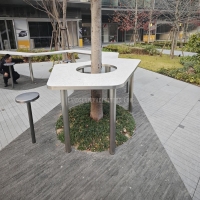Welcome to the website for landscape facilities products and knowledge.
How do UV-resistant materials prevent fading and degradation in landscape chairs exposed to sunlight?
Landscape chairs exposed to sunlight face constant threats from UV radiation, which can cause fading, brittleness, and structural degradation over time. UV-resistant materials are engineered to combat these effects through advanced chemical formulations and protective layers.
One key method is the incorporation of UV stabilizers, such as hindered amine light stabilizers (HALS) or UV absorbers, which either absorb harmful UV rays or neutralize free radicals generated by sunlight exposure. These additives are blended into plastics, fabrics, or coatings during manufacturing, creating a barrier that slows down molecular breakdown.
For example, high-density polyethylene (HDPE) chairs often include carbon black or titanium dioxide pigments that scatter UV radiation, while powder-coated aluminum frames use UV-resistant topcoats to reflect sunlight. Textile solutions like solution-dyed acrylic fibers lock in color at the molecular level, preventing fading even after years of sun exposure.
Additionally, some materials feature microscopic surface structures that diffuse light, reducing direct UV absorption. Regular maintenance, like cleaning and applying protective sprays, can further extend the lifespan of UV-resistant landscape chairs. By combining these technologies, manufacturers create outdoor furniture that retains its appearance and functionality despite prolonged sunlight exposure.
The result is landscape furniture that maintains vibrant colors and structural integrity for seasons, offering both aesthetic appeal and long-term value for outdoor spaces.
Related search:

Recommendation
An outdoor bar counter with stainless steel and terrazzo materials in an irregular shape